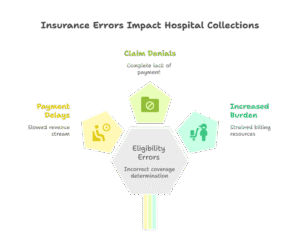Accurate insurance eligibility verification is a crucial part of the revenue cycle in healthcare. When errors occur during this process, it can lead to significant disruptions in the collection of payments, impacting both hospital finances and patient satisfaction. Errors in insurance eligibility verification can lead to claim denials, delayed reimbursements, or even uncollectible accounts. In this article, we will explore how errors in insurance eligibility affect collections and outline strategies to minimize these issues.
The Role of Insurance Eligibility Verification in Healthcare
Insurance eligibility verification is the process by which healthcare providers confirm a patient’s insurance coverage before services are rendered. This step involves checking whether a patient’s insurance policy is active, whether the services required are covered, and whether the patient has met their deductible or out-of-pocket maximum.
Effective insurance eligibility verification helps hospitals ensure that:
-
The correct payer information is on file
-
Services rendered are covered under the patient’s insurance plan
-
Accurate billing codes are applied
-
Claims are submitted correctly to avoid denials
When eligibility errors occur, it directly affects the hospital’s ability to collect payments for services provided.
Common Insurance Eligibility Errors
Several common errors can occur during the insurance eligibility verification process. These errors, while often preventable, can significantly impact a hospital’s collections process.
-
Incorrect or Outdated Insurance Information
One of the most common eligibility errors occurs when the patient’s insurance information is outdated or incorrect. This could be because the patient has changed insurance plans, switched employers, or the information was not updated in the hospital’s system. When claims are submitted with incorrect insurance details, they are often denied or delayed by the payer, affecting collections. -
Failure to Verify Active Insurance Coverage
Sometimes, hospitals fail to verify whether a patient’s insurance coverage is active at the time of service. This could happen if the verification process is rushed or not completed properly. If a patient’s insurance is inactive or has expired, the hospital may not be reimbursed for services rendered, leading to financial losses. -
Errors in Coverage Type
Another frequent error occurs when the wrong type of coverage is selected. For example, a hospital may mistakenly assume a patient is covered under a primary insurance plan, when in fact they are only covered under secondary insurance. This can lead to complications when submitting claims, resulting in partial or no reimbursement. -
Failure to Verify Payer Restrictions or Limits
Payers often have specific rules, limits, and requirements for coverage, such as needing prior authorization or adhering to specific benefit limits. Failing to verify these restrictions before providing services can result in denied claims or reduced payments. -
Wrong Payer Details
Incorrect payer information, such as submitting claims to the wrong insurer or using incorrect policy numbers, can cause delays in payments. If claims are sent to the wrong payer or contain incorrect policy numbers, the hospital must refile the claims with the correct information, causing significant delays in collections. -
Errors with Coordination of Benefits (COB)
For patients who have multiple insurance plans, there must be a correct order of benefits. Coordination of Benefits (COB) issues arise when the order of primary and secondary payers is not identified correctly. If COB errors are made, it can result in denied claims, delays in payment, or incorrect billing.
Impact of Insurance Eligibility Errors on Hospital Collections

Errors in insurance eligibility verification can have far-reaching consequences for hospitals, particularly when it comes to collections. The impact includes:
-
Claim Denials and Delays
One of the most immediate impacts of eligibility errors is claim denials. Insurers may reject claims if the patient’s coverage is not properly verified or if there are discrepancies in the submitted insurance information. When claims are denied, the hospital must go through the process of appealing the decision or resubmitting the claim, which delays the collection of revenue and increases administrative costs. -
Underpayments and Overpayments
Insurance eligibility errors can also result in underpayments or overpayments. If a hospital submits claims based on inaccurate coverage information, the insurer may pay less than the amount owed, resulting in underpayment. On the other hand, if an error leads to the submission of incorrect information, the insurer may pay more than required, leading to the need for repayment. -
Increased Accounts Receivable
When insurance eligibility issues are not addressed quickly, it leads to an increase in the hospital’s accounts receivable (AR). This means the hospital has more outstanding bills to follow up on, which can tie up resources and increase the time it takes to collect revenue. As AR grows, the hospital’s financial health may be affected, and the likelihood of receiving full payment decreases. -
Patient Financial Responsibility
When insurance eligibility errors occur, patients may become responsible for the costs of services that would have otherwise been covered by their insurance. This can lead to patient dissatisfaction and may increase the likelihood of non-payment. Patients may be reluctant or unable to pay large bills, resulting in bad debt for the hospital. -
Cash Flow Disruptions
The overall cash flow of the hospital can be disrupted due to eligibility errors. Since the hospital depends on timely reimbursement for services rendered, any delay in the process due to eligibility verification errors can cause liquidity problems. Without proper cash flow, hospitals may face difficulties in covering operational expenses. -
Increased Administrative Costs
When eligibility errors occur, administrative costs increase as additional time and resources are needed to correct mistakes. This can include staff time spent re-verifying insurance details, resubmitting claims, and managing appeals for denied claims. Hospitals may also need to invest in additional software or personnel to handle the backlog of claims.
Best Practices to Minimize Insurance Eligibility Errors
Hospitals can take several steps to reduce errors in insurance eligibility verification, improving the accuracy of claims and speeding up collections. Some best practices include:
-
Invest in Automated Eligibility Verification Tools
Many hospitals use automated eligibility verification systems that allow real-time verification of patient insurance details. These tools can automatically check whether insurance coverage is active, identify any discrepancies, and flag potential issues before services are provided. -
Regularly Update Patient Information
Hospitals should establish processes to regularly update patient insurance information. This includes confirming insurance details at each visit and using patient portals or administrative staff to ensure that records are accurate. -
Establish Clear Verification Protocols
Clear protocols should be established for insurance eligibility verification, ensuring that all necessary information is collected and verified before services are rendered. This includes confirming payer details, eligibility status, and coverage limits. -
Train Staff on Eligibility Verification Best Practices
Administrative staff responsible for verifying insurance eligibility should be thoroughly trained on best practices and updated on changes to insurance policies, payer rules, and industry standards. Regular training ensures that staff is equipped to handle complex verification tasks and avoid errors. -
Coordinate with Payers
Hospitals should maintain close communication with insurance payers to ensure that the most up-to-date eligibility information is available. This includes working with payers to resolve discrepancies in coverage and handling any coordination of benefits issues that arise. -
Monitor and Audit Eligibility Processes Regularly
Routine audits of the insurance eligibility verification process can help identify areas for improvement. Hospitals should monitor claim denials related to eligibility and use this data to refine verification processes. -
Provide Transparent Patient Communication
Ensure that patients are well-informed about their insurance coverage, including their financial responsibility. Clear communication can reduce the chances of disputes over payment and improve patient satisfaction when eligibility errors are discovered.
What Did We Learn?
Errors in insurance eligibility verification can lead to significant disruptions in a hospital’s collections process. These errors can result in claim denials, underpayments, and delays in reimbursements, ultimately impacting the hospital’s revenue cycle and financial health. By implementing best practices such as automating verification, training staff, and maintaining accurate patient information, hospitals can reduce eligibility errors and streamline their collections process. Ensuring that insurance eligibility is verified accurately and efficiently is critical for maintaining financial stability and delivering high-quality patient care.
What People Are Asking?
What is insurance eligibility verification?
It’s the process of confirming a patient’s insurance coverage status before services are provided to ensure correct billing and reimbursement.
How do eligibility errors impact hospital collections?
Errors lead to claim denials, underpayments, delays in reimbursements, and increased accounts receivable, all of which disrupt cash flow.
What are common insurance eligibility errors?
Common errors include incorrect or outdated patient information, failure to verify active coverage, errors in coverage type, and missing payer details.
How can hospitals prevent eligibility verification errors?
By using automated verification tools, training staff regularly, maintaining updated patient records, and establishing clear verification protocols.
What happens when a patient’s insurance is incorrectly verified?
The hospital may face delays in payment, patients may become responsible for unpaid bills, and administrative costs may rise due to the need for claim corrections.
Disclaimer:
For informational purposes only; not applicable to specific situations.
For tailored support and professional services
Please contact Staffingly, Inc. at (800) 489-5877
Email: support@staffingly.com
About This Blog: This Blog is brought to you by Staffingly, Inc., a trusted name in healthcare outsourcing. The team of skilled healthcare specialists and content creators is dedicated to improving the quality and efficiency of healthcare services. The team passionate about sharing knowledge through insightful articles, blogs, and other educational resources.
 Book a Demo to Build Your Team Today!
Book a Demo to Build Your Team Today!


 Read Case Studies
Read Case Studies 



 Virtual Medical Assistants
Virtual Medical Assistants



